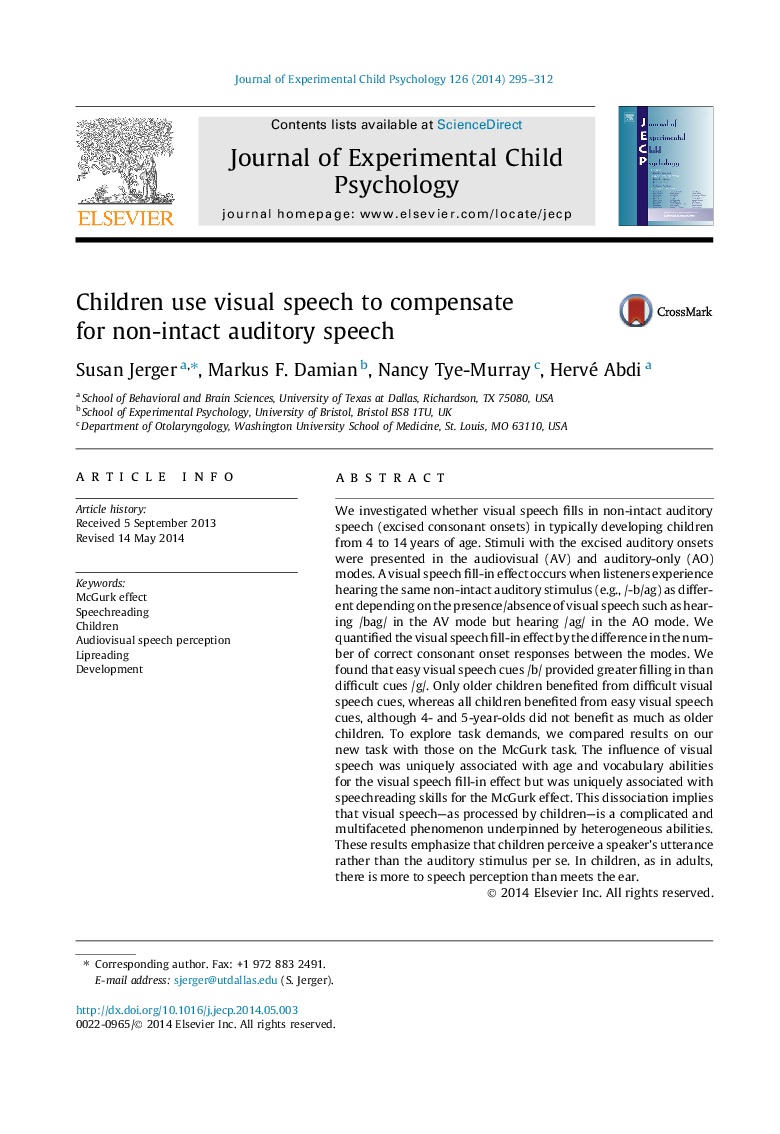| کد مقاله | کد نشریه | سال انتشار | مقاله انگلیسی | نسخه تمام متن |
|---|---|---|---|---|
| 7275390 | 1473486 | 2014 | 18 صفحه PDF | دانلود رایگان |
عنوان انگلیسی مقاله ISI
Children use visual speech to compensate for non-intact auditory speech
ترجمه فارسی عنوان
بچه ها از گفتار بصری برای جبران سخن شنوایی غیرقابل استفاده می کنند
دانلود مقاله + سفارش ترجمه
دانلود مقاله ISI انگلیسی
رایگان برای ایرانیان
کلمات کلیدی
موضوعات مرتبط
علوم انسانی و اجتماعی
روانشناسی
روانشناسی رشد و آموزشی
چکیده انگلیسی
We investigated whether visual speech fills in non-intact auditory speech (excised consonant onsets) in typically developing children from 4 to 14Â years of age. Stimuli with the excised auditory onsets were presented in the audiovisual (AV) and auditory-only (AO) modes. A visual speech fill-in effect occurs when listeners experience hearing the same non-intact auditory stimulus (e.g., /-b/ag) as different depending on the presence/absence of visual speech such as hearing /bag/ in the AV mode but hearing /ag/ in the AO mode. We quantified the visual speech fill-in effect by the difference in the number of correct consonant onset responses between the modes. We found that easy visual speech cues /b/ provided greater filling in than difficult cues /g/. Only older children benefited from difficult visual speech cues, whereas all children benefited from easy visual speech cues, although 4- and 5-year-olds did not benefit as much as older children. To explore task demands, we compared results on our new task with those on the McGurk task. The influence of visual speech was uniquely associated with age and vocabulary abilities for the visual speech fill-in effect but was uniquely associated with speechreading skills for the McGurk effect. This dissociation implies that visual speech-as processed by children-is a complicated and multifaceted phenomenon underpinned by heterogeneous abilities. These results emphasize that children perceive a speaker's utterance rather than the auditory stimulus per se. In children, as in adults, there is more to speech perception than meets the ear.
ناشر
Database: Elsevier - ScienceDirect (ساینس دایرکت)
Journal: Journal of Experimental Child Psychology - Volume 126, October 2014, Pages 295-312
Journal: Journal of Experimental Child Psychology - Volume 126, October 2014, Pages 295-312
نویسندگان
Susan Jerger, Markus F. Damian, Nancy Tye-Murray, Hervé Abdi,
